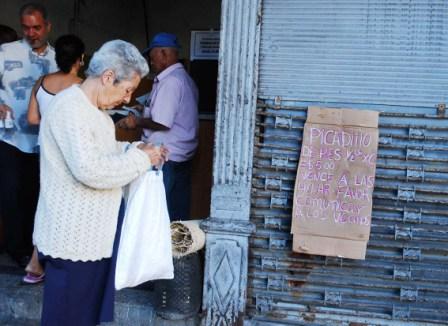What Reaches Cuba’s People
Yusimi Rodriguez

HAVANA TIMES, Jan. 13 — At this Report-back Assembly (introduced in Part I), Pedro raised his third point, contending there was a lack of real commitment to solving the problems of the community. Other residents had previously complained about serious problems with their buildings and the lack of public lighting.
As I noted in my earlier entry concerning Report-back Assemblies, in these meetings the delegates must report to their constituencies on their administrative activities and the steps they’ve taken to solve problems identified by the residents, as well as the difficulties they’ve encountered in addressing these.
This was done by the Alamar district delegate at the beginning of the meeting.

In his end of the year report for 2008, he said the area had been provided with inadequate resources during that period and would receive even less in 2009. (One should recall that the island had just been hit by two back-to-back hurricanes in September 2008.) However, the delegate noted —less than a minute after stating there were no resources— that a few resources did in fact exist, and that these would be distributed for building repairs. However, he added, since these were in such short supply, it had been decided to earmark them for “Plan Image.”
Plan Image consisted of repairing those buildings located on the main streets of the large Alamar housing projects suburb, as well as ensuring the public lighting of these avenues.
The buildings located along Alamar’s main avenues are those that can be seen from a bus, or state and private cars, and…by tourists. The impression one gets of the area depends on the outer appearance of these buildings.

Pedro thought the decision to prioritize them would have been right if those who live in buildings whose repairs would be sacrificed for the Plan participated in them. That’s to say, those that would have to give up the resources due them —for who knows how long— for the sake of the area’s image.
However, residents from other parts of the neighborhood —like Pedro himself, whose building didn’t have the privilege of being located on a main avenue— were not consulted; they were only informed about the final decision on the appropriation of the scarce funding.
Pedro also asked who exactly had made the decision about distributing the scant resources for repairs – but he didn’t receive an answer; the delegate talked the whole time using the impersonal “they,” without directly identifying anyone.
Personally, I wonder —using the impersonal form, since there’s no alternative— whether “they” made a needs assessment of each apartment in every building to find out where the greatest problems existed. Isn’t this what “they” would have to consider in order to establish priorities, if resources were indeed scarce?

Regarding the lack of public lighting, the delegate said that a crew of electricians was changing bulbs and lamps near the community, and that he would request them to do the favor of coming to the area to supply the needed materials so that residents could do the installation work on their own.
Pedro began by responding that for the electrical crew to do this “favor,” they would have to divert resources committed to some other job, and therefore they would be breaking the law – which is no way to solve problems.
What’s more, he said, to perform electrical installations is the job of the electric company, whose employees possess the knowledge required for that type of work and who get paid to do just that. His main argument was that if unskilled residents carried out the installations on their own, as the delegate proposed, someone might even wind up electrocuted.

Pedro concluded by requesting that a report be made to the residents on the actual amount of funding available for solving the problems and how it was proposed to be distributed. Supposedly this is discussed at the municipal deputies’ level, Pedro said; however, that information doesn’t reach the people. Only vague reports are given, not exact figures.
When Pedro finished speaking, the residents began to applaud. What’s certain is that he hadn’t said anything new, though perhaps he had been able to articulate it in a manner that was more coherent and dynamic than usual.
People didn’t leave the meeting with the certainty that some of their problems would be solved or with more hope than before. But at least they felt there was some reason for high spirits, since things were finally said the way they should be.
If that had been a movie, this would have been the scene of the happy ending: the leading character receiving the residents’ heartfelt applause. But I’ve only referred to the first of two meetings of Report-back Assemblies that took place in this section of Alamar. The second —which I’ll describe in my next entry— didn’t have such a happy outcome.






Yusimi, in the US there are about 50 million households that live in dwellings owned by landlords. Renters pay for everything–mortgage, repairs, insurance–everything; but get not ownership equity whatsoever.
At the same time they have to put up a “security deposit–usually equivalent to one month’s rent–plus a “last month’s” rent deposit.
These households must live by the rules of the landlord, which usually means things like no pets, and sometimes inhuman things like no children. All in all, the 150-200 million women, men and kids living in these dwellings are tenant serfs . . . and this is called “freedom” by those who love this system.
In fact, it is freedom–the freedom of capitalists and banks to feed like leeches on the working people and reduce them to the condition of serfdom.
The owners of these dwellings live in other districts; much nicer districts. It’s what’s called The American Dream. So, when you think about Cuba’s housing problems . . .